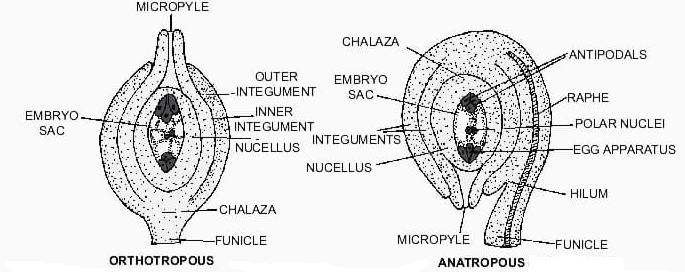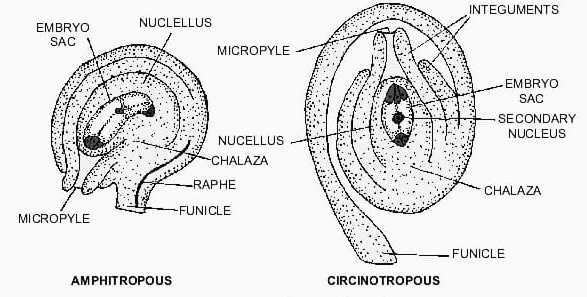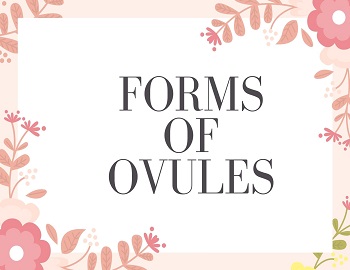Forms of Ovules:
The megasporangium along with its protective coats, namely integuments, is known as the ovule. The ovule is the forerunner of the seed. Therefore, the study of the megasporangium or the ovule is most important for an understanding of the structure and function of the seed.
The ovules are classified into six main types based on the orientation, form and position of the micropyle with respect to funicle and chalaza-
- Orthotropous Ovule- The body of the ovule lies straight and upright over the funicle. Hilum, chalaza and micropyle occur on the same line with hilum and chalaza nearby. Example- Piperaceae, Polygonaceae, Urticaceae.
- Anatropous Ovule- The body of the ovule is inverted and gets fused with funiculus along its whole length on one side. The fused funiculus forms ridge called raphe. Hilum and micropyle are nearby with chalaza on the opposite side. It is the most common, in about 82% of angiosperms. Example- Helianthus.

- Hemianatropous or Hemitropous Ovule- The body of the ovule is twisted only halfway so that the degree of curvature is intermediate between orthotropous and anatropous, i.e. at right angle to the funicle. The micropyle-chalaza line is horizontal and placed at 90° to the line of the funicle. The embryo sac is straight but horizontal with its egg apparatus facing towards the micropyle. Example- Primulaceae, Ranunculaceae and some Cruciferae.
- Campylotropous Ovule- The body of the ovule at the micropylar end is curved and more or less bean-shaped. The embryo sac is slightly curved. All the three, hilum, micropyle and chalaza are adjacent to one another, with the micropyle oriented towards the placenta. Example- Capparis, Capsella, Caryophyllaceae, Chenopodiaceae, Some legumes.

- Amphitropous Ovule- The curvature of the ovule is more pronounced here and the curvature also extends to the embryo sac which becomes horse-shoe shaped. Example- Alismataceae, Butomaceae, Amaranthaceae.
- Circinotropous Ovule- It is a very peculiar type of ovule in which the funicle is exceptionally long and forms a complete circle around the ovule but is free from it except for a small area of attachment at the end of the funicle. It occurs mostly in the members of Cactaceae and also in a few taxa of Plumbaginaceae.










Comments (No)